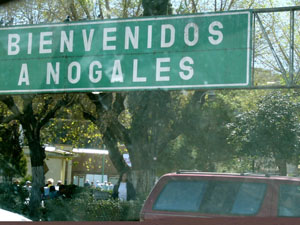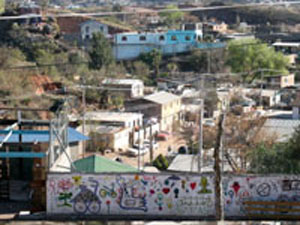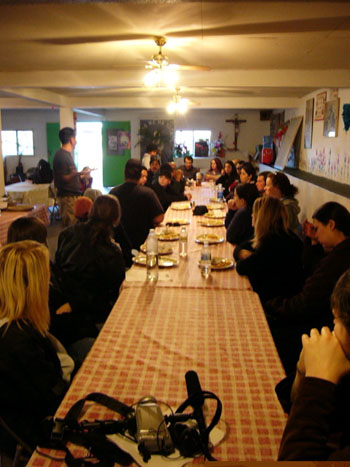
BorderLinks Field Trip to Nogales, Mexico

I have been to Nogales several times before, although this particular visit was very different from my previous trips. When I went before, we always parked in one of the parking lots on the Arizona side of Nogales and walked across the border. We mainly just explored all of the tourist areas and shops. Since we were on foot, we could not go too far. Going to Nogales with the people from BorderLinks was an entirely different experience. Even though we barely scratched the surface, I feel that I got to have a better understanding about the people and what a day in their lives might be like. The parts of the field trip that I enjoyed most were listening to Kat Rodriguez of the Coalición de Derechos Humanos, visiting a family's home for lunch, and visiting the Mercy House.
For the first leg of the journey, we stopped at the BorderLinks house in Tucson. While we were there we had the opportunity to listen to and ask questions of Kat Rodriguez. The Coalición de Derechos Humanos, or Human Rights Coalition, is an organization that stands up for human rights and fights militarization and violence along the border. She explained to us about the mistreatment vigilante groups impose on the Mexicans who try to cross into the United States as well as discrimination and abuse by the federal, state, and local law enforcement. Another issue she brought to our attention is the deaths of many Mexicans attempting cross the border. The article Border Death-Trap: Time to Tear Down America's Berlin Wall, by Joseph Nevins, from the BorderLinks packet also touches on this problem, listing a death toll of 2,000 migrants between 1995 and July, 2002. Both Kat and Nevins talk about the United States government's role in these deaths. Part of the problem is the laws that the government makes to try to discourage illegal immigration. But, unfortunately, instead of discouraging the immigrants, it just makes it harder and more dangerous for them to cross. The fences do not keep the illegal crossers out of the United States; it just forces them to go to the more dangerous areas that are left open. Kat also explained that the government death tolls are inaccurate. The official count only considers the areas right by the border and do not include the skeletons found of people who have died in previous years. Too many people slip through the cracks, with their families never knowing if they made it or not. Kat also made it very clear that not everyone involved in law enforcement is bad, and that not all immigrants have good intentions.
After
listening to Kat, we divided into groups to drive to Nogales. After
touring U.S. Customs, we drove further into Nogales to the colonia of
Bella Vista. Driving through the neighborhoods was an eye opening
experience.
 Most
of the homes appeared to be very run down and tiny, while some of the
homes were extremely large and would probably be very expensive if the
same house was to be built in Phoenix. There really did not seem to be
any medium; we observed either extreme poverty, or great wealth.
Most
of the homes appeared to be very run down and tiny, while some of the
homes were extremely large and would probably be very expensive if the
same house was to be built in Phoenix. There really did not seem to be
any medium; we observed either extreme poverty, or great wealth.
When we got to Bella Vista each group got to eat lunch with a different family. During lunch, the group I was in got the chance to get to know Rosa, the matriarch of the house where we ate. Like most people in Nogales, both she and her husband were not from there originally. They both had their own land in southern Sonora, but had migrated to Nogales five years ago. With children and grandchildren, they had a total of 11 people living with them. I could not imagine living with that many people, let alone in a house so small. Even so, they all seemed to be happy. Her grandchildren were adorable and ran around the house playing the whole time we were there. Rosa did not have a visa to come to the United States, but one of her daughters did. She said that when her daughter would run out of money, she would go to Tucson for a week or so to earn some money and then come back to Nogales. Rosa has also known people who have crossed illegally into the United States, but thankfully none of them had died in the process. She said they came to the U.S. because they could not make enough money in Mexico to live of off and feed their families, which makes me think of another problem.
If people like Rosa’s family can not even afford to keep shelter over their heads and food on their tables, how can they afford to take care of their health? The article Two Countries, One Population, Shared Problems Community Health in the Borderlands: An Overview, once again from the BorderLinks packet, speaks of the health risks that the people in the colonias are faced with. A poor water supply leads to hepatitis A, crowded living conditions leads to tuberculosis and typhoid fever, and these diseases in addition to AIDS and rubella can go unnoticed without regular healthcare. This is not only a problem for the Mexican side of the border, but for the American side as well. Disease does not know what a "border" is.
 After
lunch and touring the maquiladora, we went to the Casa de la
Misericordia, the Borderlinks community center in Nogales. One of the
many programs the Casa runs is a lunch program to feed children who
might not get food otherwise. At the Casa, we had a wonderful dinner and
learned about how the Casa was started. After dinner, listening to Kiko
Trujillo, the Borderlinks Mexican director, summed up the day. I think
that the trip to Nogales was a wonderful experience. As much as you
learn in the classroom, there is no substitute for being able to
actually go and walk amongst the people we are studying about.
BorderLinks is an organization that is much needed today to educate and
raise awareness of the needs and hardships of the people who so
desperately want migrate to the United States.
After
lunch and touring the maquiladora, we went to the Casa de la
Misericordia, the Borderlinks community center in Nogales. One of the
many programs the Casa runs is a lunch program to feed children who
might not get food otherwise. At the Casa, we had a wonderful dinner and
learned about how the Casa was started. After dinner, listening to Kiko
Trujillo, the Borderlinks Mexican director, summed up the day. I think
that the trip to Nogales was a wonderful experience. As much as you
learn in the classroom, there is no substitute for being able to
actually go and walk amongst the people we are studying about.
BorderLinks is an organization that is much needed today to educate and
raise awareness of the needs and hardships of the people who so
desperately want migrate to the United States.